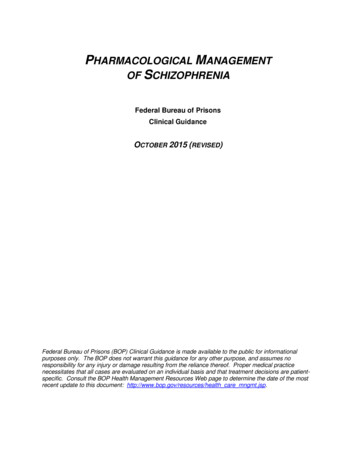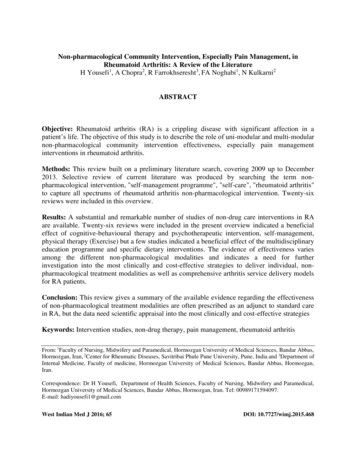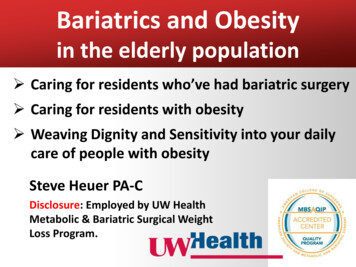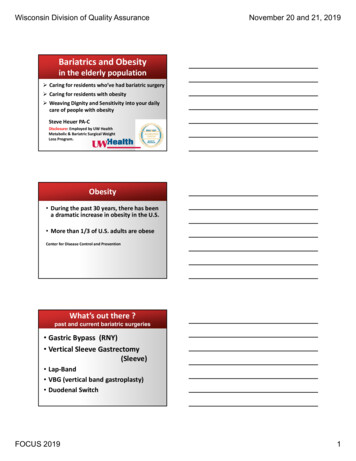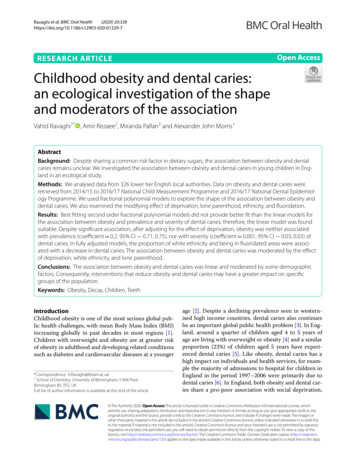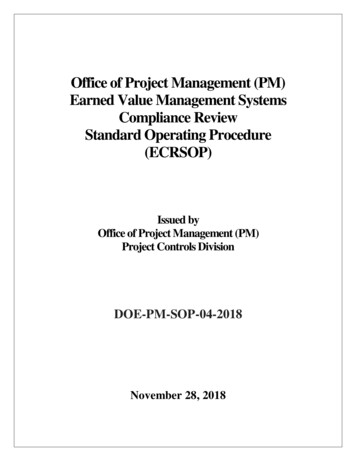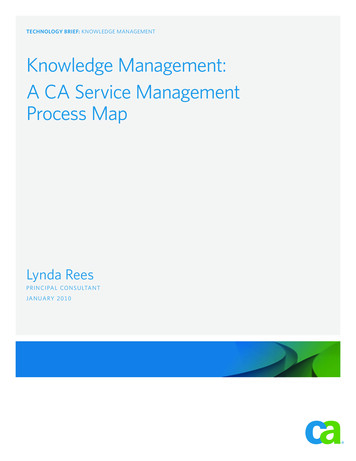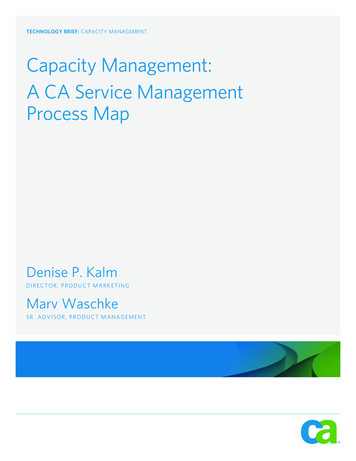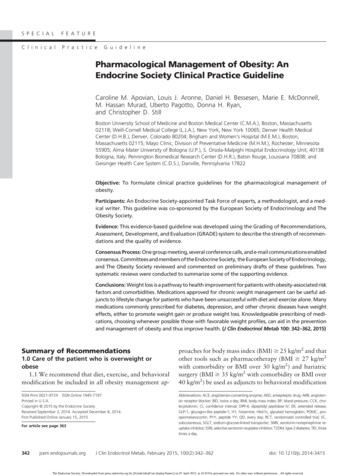
Transcription
S P E C I A LF E A T U R EC l i n i c a lP r a c t i c eG u i d e l i n ePharmacological Management of Obesity: AnEndocrine Society Clinical Practice GuidelineCaroline M. Apovian, Louis J. Aronne, Daniel H. Bessesen, Marie E. McDonnell,M. Hassan Murad, Uberto Pagotto, Donna H. Ryan,and Christopher D. StillBoston University School of Medicine and Boston Medical Center (C.M.A.), Boston, Massachusetts02118; Weill-Cornell Medical College (L.J.A.), New York, New York 10065; Denver Health MedicalCenter (D.H.B.), Denver, Colorado 80204; Brigham and Women’s Hospital (M.E.M.), Boston,Massachusetts 02115; Mayo Clinic, Division of Preventative Medicine (M.H.M.), Rochester, Minnesota55905; Alma Mater University of Bologna (U.P.), S. Orsola-Malpighi Hospital Endocrinology Unit, 40138Bologna, Italy; Pennington Biomedical Research Center (D.H.R.), Baton Rouge, Louisiana 70808; andGeisinger Health Care System (C.D.S.), Danville, Pennsylvania 17822Objective: To formulate clinical practice guidelines for the pharmacological management ofobesity.Participants: An Endocrine Society-appointed Task Force of experts, a methodologist, and a medical writer. This guideline was co-sponsored by the European Society of Endocrinology and TheObesity Society.Evidence: This evidence-based guideline was developed using the Grading of Recommendations,Assessment, Development, and Evaluation (GRADE) system to describe the strength of recommendations and the quality of evidence.Consensus Process: One group meeting, several conference calls, and e-mail communications enabledconsensus. Committees and members of the Endocrine Society, the European Society of Endocrinology,and The Obesity Society reviewed and commented on preliminary drafts of these guidelines. Twosystematic reviews were conducted to summarize some of the supporting evidence.Conclusions: Weight loss is a pathway to health improvement for patients with obesity-associated riskfactors and comorbidities. Medications approved for chronic weight management can be useful adjuncts to lifestyle change for patients who have been unsuccessful with diet and exercise alone. Manymedications commonly prescribed for diabetes, depression, and other chronic diseases have weighteffects, either to promote weight gain or produce weight loss. Knowledgeable prescribing of medications, choosing whenever possible those with favorable weight profiles, can aid in the preventionand management of obesity and thus improve health. (J Clin Endocrinol Metab 100: 342–362, 2015)Summary of Recommendations1.0 Care of the patient who is overweight orobese1.1 We recommend that diet, exercise, and behavioralmodification be included in all obesity management apISSN Print 0021-972X ISSN Online 1945-7197Printed in U.S.A.Copyright 2015 by the Endocrine SocietyReceived September 3, 2014. Accepted December 8, 2014.First Published Online January 15, 2015For article see page 363342jcem.endojournals.orgproaches for body mass index (BMI) ⱖ 25 kg/m2 and thatother tools such as pharmacotherapy (BMI ⱖ 27 kg/m2with comorbidity or BMI over 30 kg/m2) and bariatricsurgery (BMI ⱖ 35 kg/m2 with comorbidity or BMI over40 kg/m2) be used as adjuncts to behavioral modificationAbbreviations: ACE, angiotensin-converting enzyme; AED, antiepileptic drug; ARB, angiotensin receptor blocker; BID, twice a day; BMI, body mass index; BP, blood pressure; CCK, cholecystokinin; CI, confidence interval; DPP-4, dipeptidyl peptidase IV; ER, extended release;GLP-1, glucagon-like peptide-1; H1, histamine; HbA1c, glycated hemoglobin; POMC, proopiomelanocortin; PYY, peptide YY; QD, every day; RCT, randomized controlled trial; SC,subcutaneous; SGLT, sodium-glucose-linked transporter; SNRI, serotonin-norepinephrine reuptake inhibitor; SSRI, selective serotonin reuptake inhibitor; T2DM, type 2 diabetes; TID, threetimes a day.J Clin Endocrinol Metab, February 2015, 100(2):342–362doi: 10.1210/jc.2014-3415The Endocrine Society. Downloaded from press.endocrine.org by [ {individualUser.displayName}] on 07 April 2015. at 10:49 For personal use only. No other uses without permission. . All rights reserved.
doi: 10.1210/jc.2014-3415to reduce food intake and increase physical activity whenthis is possible. Drugs may amplify adherence to behaviorchange and may improve physical functioning such thatincreased physical activity is easier in those who cannotexercise initially. Patients who have a history of being unable to successfully lose and maintain weight and whomeet label indications are candidates for weight loss medications. (1 QQQQ)1.2 In order to promote long-term weight maintenance,we suggest the use of approved1 weight loss medication(over no pharmacological therapy) to ameliorate comorbidities and amplify adherence to behavior changes, whichmay improve physical functioning and allow for greaterphysical activity in individuals with a BMI ⱖ 30 kg/m2 orin individuals with a BMI of ⱖ 27 kg/m2 and at least oneassociated comorbid medical condition such as hypertension, dyslipidemia, type 2 diabetes (T2DM), and obstructive sleep apnea. (2 QQEE)1.3 In patients with uncontrolled hypertension or a history of heart disease, we recommend against using thesympathomimetic agents phentermine and diethylpropion. (1 QQQE)1.4 We suggest assessment of efficacy and safety atleast monthly for the first 3 months, then at least every3 months in all patients prescribed weight loss medications. (2 QQEE)1.5 If a patient’s response to a weight loss medicationis deemed effective (weight loss ⱖ 5% of body weight at3 mo) and safe, we recommend that the medication becontinued. If deemed ineffective (weight loss 5% at 3mo) or if there are safety or tolerability issues at any time,we recommend that the medication be discontinued andalternative medications or referral for alternative treatment approaches be considered. (1 QQQQ)1.6 If medication for chronic obesity management isprescribed as adjunctive therapy to comprehensive lifestyle intervention, we suggest initiating therapy with doseescalation based on efficacy and tolerability to the recommended dose and not exceeding the upper approved doseboundaries. (2 QQEE)1.7 In patients with T2DM who are overweight orobese, we suggest the use of antidiabetic medications thathave additional actions to promote weight loss (such asglucagon-like peptide-1 [GLP-1] analogs or sodium-glucose-linked transporter-2 [SGLT-2] inhibitors), in addition to the first-line agent for T2DM and obesity, metformin. (2 QQQE)1.8 In patients with cardiovascular disease who seekpharmacological treatment for weight loss, we suggest us-jcem.endojournals.org343ing medications that are not sympathomimetics such aslorcaserin and/or orlistat. (2 QEEE)2.0 Drugs that cause weight gain and somealternatives2.1 We recommend weight-losing and weight-neutralmedications as first- and second-line agents in the management of a patient with T2DM who is overweight orobese. Clinicians should discuss possible weight effects ofglucose-lowering medications with patients and considerthe use of antihyperglycemic medications that are weightneutral or promote weight loss. (1 QQQE)2.2 In obese patients with T2DM requiring insulintherapy, we suggest adding at least one of the following:metformin, pramlintide, or GLP-1 agonists to mitigateassociated weight gain due to insulin. The first-line insulin for this type of patient should be basal insulin. Thisis preferable to using either insulin alone or insulin withsulfonylurea. We also suggest that the insulin therapystrategy be considered a preferential trial of basal insulin prior to premixed insulins or combination insulintherapy. (2 QQQE)2.3 We recommend angiotensin-converting enzyme(ACE) inhibitors, angiotensin receptor blockers (ARBs),and calcium channel blockers rather than -adrenergicblockers as first-line therapy for hypertension in patientswith T2DM who are obese. (1 QQQQ)2.4 When antidepressant therapy is indicated, we recommend a shared decision-making process that providespatients with quantitative estimates of the expected weighteffect of the antidepressant to make an informed decisionabout drug choice. Other factors that need to be taken intoconsideration include the expected length of treatment.(1 QQQE)2.5 We recommend using weight-neutral antipsychoticalternatives when clinically indicated, rather than thosethat cause weight gain, and the use of a shared decisionmaking process that provides patients with quantitativeestimates of the expected weight effect of the alternativetreatments to make an informed decision about drugchoice. (1 QQQE)2.6 We recommend considering weight gain potentialin choosing an antiepileptic drug (AED) for any given patient, and the use of a shared decision-making process thatprovides patients with quantitative estimates of the expected weight effect of the drugs to make an informeddecision about drug choice. (1 QQQE)2.7 In women with a BMI 27 kg/m2 with comorbidities or BMI 30 kg/m2 seeking contraception, we suggestoral contraceptives over injectable medications due to1Approval in the United States is based on FDA determination. Approval in Europe is basedon EMA determination.The Endocrine Society. Downloaded from press.endocrine.org by [ {individualUser.displayName}] on 07 April 2015. at 10:49 For personal use only. No other uses without permission. . All rights reserved.
344Apovian et alGuidelines on Pharmacological Management of Obesityweight gain with injectables, provided that women arewell-informed about the risks and benefits (ie, oral contraceptives are not contraindicated). (2 QEEE)2.8 We suggest monitoring the weight and waist circumference of patients on antiretroviral therapy due tounavoidable weight gain, weight redistribution, and associated cardiovascular risk. (2 QQQE)2.9 We suggest the use of nonsteroidal anti-inflammatory drugs and disease-modifying antirheumatic drugswhen possible in patients with chronic inflammatory disease like rheumatoid arthritis because corticosteroidscommonly produce weight gain. (2 QQQE)2.10 We suggest the use of antihistamines with lesscentral nervous system activity (less sedation) to limitweight gain. (2 QQEE)3.0 Off-label use of drugs approved for otherindications for chronic obesity management3.1 We suggest against the off-label use of medications approved for other disease states for the sole purpose of producing weight loss. A trial of such therapycan be attempted in the context of research and byhealthcare providers with expertise in weight management dealing with a well-informed patient. (UngradedBest Practice Recommendation)Method of Development of EvidenceBased Clinical Practice Guidelineshe Clinical Guidelines Subcommittee (CGS) of the Endocrine Society deemed the pharmacological management of obesity a priority area in need of practiceguidelines and appointed a Task Force to formulate evidence-based recommendations. The Task Force followedthe approach recommended by the Grading of Recommendations, Assessment, Development, and Evaluation(GRADE) group, an international group with expertise inthe development and implementation of evidence-basedguidelines (1). A detailed description of the gradingscheme has been published elsewhere (2). The Task Forceused the best available research evidence to develop therecommendations. The Task Force also used consistentlanguage and graphical descriptions of both the strengthof a recommendation and the quality of evidence. In termsof the strength of the recommendation, strong recommendations use the phrase “we recommend” and the number1, and weak recommendations use the phrase “we suggest” and the number 2. Cross-filled circles indicatethe quality of the evidence, such that QEEE denotes verylow quality evidence; QQEE, low quality; QQQE, moderate quality; and QQQQ, high quality. The Task ForceTJ Clin Endocrinol Metab, February 2015, 100(2):342–362has confidence that persons who receive care according tothe strong recommendations will derive, on average, moregood than harm. Weak recommendations require morecareful consideration of the person’s circumstances, values, and preferences to determine the best course of action.Linked to each recommendation is a description of theevidence and the values that panelists considered in making the recommendation; in some instances, there are remarks, a section in which panelists offer technical suggestions for testing conditions, dosing, and monitoring.These technical comments reflect the best available evidence applied to a typical person being treated. Often thisevidence comes from the unsystematic observations of thepanelists and their values and preferences; therefore, theseremarks should be considered suggestions.The Endocrine Society maintains a rigorous conflictof-interest review process for the development of clinicalpractice guidelines. All Task Force members must declareany potential conflicts of interest, which are reviewed before they are approved to serve on the Task Force andperiodically during the development of the guideline. Theconflict-of-interest forms are vetted by the CGS before themembers are approved by the Society’s Council to participate on the guideline Task Force. Participants in theguideline development must include a majority of individuals without conflicts of interest in the matter under study.Participants with conflicts of interest may participate inthe development of the guideline, but they must have disclosed all conflicts. The CGS and the Task Force havereviewed all disclosures for this guideline and resolved ormanaged all identified conflicts of interest.Conflicts of interest are defined as remuneration in anyamount from the commercial interest(s) in the form of grants;research support; consulting fees; salary; ownership interest(eg, stocks, stock options, or ownership interest excludingdiversified mutual funds); honoraria or other payments forparticipation in speakers’ bureaus, advisory boards, orboards of directors; or other financial benefits. Completedforms are available through the Endocrine Society office.Funding for this guideline was derived solely from theEndocrine Society, and thus the Task Force received no funding or remuneration from commercial or other entities.A systematic review was commissioned by the Endocrine Society to quantify weight gain and weight loss associated with a discrete list of drugs chosen a priori by thisguideline Task Force (3). The systematic review compareda list of 54 commonly used drugs chosen a priori by theTask Force (drugs suspected of having weight implications) that were compared to placebo in randomized controlled trials. For trials to be included, the length of treatment had to be ⱖ 30 days. The outcome of interest for thereview was weight change (expressed in absolute and rel-The Endocrine Society. Downloaded from press.endocrine.org by [ {individualUser.displayName}] on 07 April 2015. at 10:49 For personal use only. No other uses without permission. . All rights reserved.
doi: 10.1210/jc.2014-3415ative terms). The Task Force also used evidence derivedfrom existing systematic reviews, randomized trials, andobservational studies on the management of medicationsfor other conditions that may result in weight gain. Economic analyses and cost effectiveness studies were not reviewed or considered as a basis for the recommendations.Drugs associated with weight gain and suggested alternatives are presented in Supplemental Table 1.In several of the recommendations, we used evidencederived from randomized clinical trials about the benefitsof shared decision making in terms of improving patients’knowledge, reducing decisional conflict and regret, andenhancing the likelihood of patients making decisionsconsistent with their own values (4). Although there isabundant evidence for the value of shared decision makingacross several clinical scenarios, specific evidence for obesity management is scant. This highlights a limitation ofthe existing literature and poses a challenge for implementing a specific strategy for shared decision making inmanaging obesity.Medical management of the disease of obesityThe Task Force agrees with the opinion of prominentmedical societies that current scientific evidence supportsthe view that obesity is a disease (5).Weight loss produces many benefits including risk factor improvement, prevention of disease, and improvements in feeling and function. Greater weight loss produces greater benefits, but modest (5 to 10%) weight loss,such as that produced by lifestyle modifications and medications, has been shown to produce significant improvements in many conditions (5, 6).Medications used for the management of conditionsother than obesity can contribute to or exacerbate weightgain in susceptible individuals. Many of these conditionsare also associated with obesity. Healthcare providers canhelp patients prevent or attenuate weight gain by appropriately prescribing medications that would promoteweight loss or minimize weight gain when treating theseconditions. Healthcare providers can help selected patients successfully lose weight by appropriately prescribing weight loss medications or in some cases surgical intervention as an adjunct to lifestyle change.This guideline will target how providers can use medications as an adjunct to lifestyle change therapy to promote weight loss and maintenance. It will also addresshow prescribers can prevent or attenuate weight gainwhen prescribing for diabetes, depression, and chronicdiseases often associated with obesity. The evidence review addresses medications with a weight loss indication,as well as those medications that affect weight when prescribed for a nonobesity indication, ie, that have been as-jcem.endojournals.org345sociated with significant weight gain and increase in riskof comorbidities or with weight loss.Clinical encounter with the patient who isoverweight or obeseThere are a number of steps a clinician should take inthe clinical encounter. Annual and symptom-based screening for majorchronic conditions associated with obesity in all adultpatients with a BMI of 30 kg/m2 or above. These includeT2DM, cardiovascular disease, hypertension, hyperlipidemia, obstructive sleep apnea, nonalcoholic fatty liverdisease, osteoarthritis, and major depression. Timely adherence to national cancer screening guidelines with the understanding that individuals who areobese are at increased risk for many malignancies (7). Identification of contributing factors, including familyhistory, sleep disorders, disordered eating, genetics, andenvironmental or socioeconomic causes. Identification of and appropriate screening for secondary causes of obesity (Table 1). These need not be automatically screened for unless the history and/or physical examination suggests the diagnosis or suspicion ofthe diagnosis. Adherence to the AHA/ACC/TOS Guideline for theManagement of Overweight and Obesity in Adults (8),which was updated in 2013 and includes recommendations for assessment and treatment with diet and exercise, as well as bariatric surgery for appropriatecandidates. Identification of medications that contribute to weightgain. Prescribe drugs that are weight neutral or thatpromote weight loss when possible. Formulation of a treatment plan based on diet, exercise,and behavior modifications as above.Rationale for pharmacological treatment ofobesityThe challenge of weight reductionIf permanent weight loss could be achieved exclusivelywith behavioral reductions in food intake and increases inenergy expenditure, medications for obesity would not beneeded. Weight loss is difficult for most patients, and thepatient’s desire to restrict food and energy intake is counteracted by adaptive biological responses to weight loss(9 –12). The fall in energy expenditure (out of proportionto reduction in body mass) and increase in appetite that areobserved after weight loss are associated with changes ina range of hormones (12–14). Some of these changes represent adaptive responses
Boston University School of Medicine and Boston Medical Center (C.M.A.), Boston, Massachusetts . and bariatric surgery (BMI 35 kg/m2 with comorbidity or BMI over 40 kg/m2) be used as adjuncts to behavioral modification ISSN Print 0021-972X ISSN Online 1945-7197 Printed in U.S.A.
